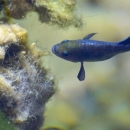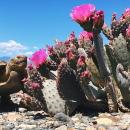About Us
The Moapa Valley National Wildlife Refuge was established on September 10, 1979, to secure habitat for the endangered Moapa dace, a small fish endemic to the headwaters of the Muddy River system. Dace populations were in peril due to habitat destruction and modification. Competition with introduced species such as mosquitofish, shortfin molly, and tilapia also contributed to the dace's decline. However, as more and more habitat is restored and non-native species are removed, the fish has begun to rebound. Recent population surveys show an increase in numbers from recent years. As of February 2024, there were 1935 dace in the Muddy River system. Biologists say that there needs to be a stable population of at least 6000 to ensure the security of the species.
The refuge is located on 136 acres in northeastern Clark County and is approximately 60 miles north of Las Vegas, Nevada. Dace habitat on the refuge consists of stream channels supported by six thermal springs, three of which are within refuge boundaries.
Entry to the Moapa Valley Natural Wildlife Refuge is always free of charge.
Reminder: The refuge is open Friday-Sunday, September-May.
Our Mission
Moapa Valley National Wildlife Refuge is part of the National Wildlife Refuge System. The mission of the National Wildlife Refuge System is to administer a national network of lands and waters for the conservation, management, and where appropriate, restoration of fish, wildlife, and plant resources and their habitats within the United States for the benefit of present and future generations of Americans.
Vision Statement
The Service's vision for the Moapa Valley NWR is:
The Moapa Valley National Wildlife Refuge supports and protects a healthy, thriving population of Moapa dace at the headwaters of the Muddy River. Stable flows from the refuge’s numerous warm springs fill meandering channels downstream that provide ideal habitat for dace, Virgin River chub and other species of endemic fish and invertebrates.
The spring bank and riparian riparian
Definition of riparian habitat or riparian areas.
Learn more about riparian plant communities provide habitat for southwestern willow flycatcher as well as a rich diversity of migratory and resident songbirds, colonial nesting species, and other native wildlife.
Local residents and visitors learn about and enjoy this restored desert oasis. Volunteers take personal satisfaction from contributing to the conservation and protection of refuge wildlife and the unique spring-nourished habitats on which they depend.
The Service will realize this vision through continued habitat restoration and maintenance, as well as, monitoring for and elimination of invasive non-native species.
Our History
Prior to acquisition, part of what is now the refuge was developed and operated as a resort, with swimming pools, bath houses, snack bars, and recreational vehicle hook-ups. The springs are thermal in nature and have an average annual water temperature of 90 degrees Fahrenheit at their points of discharge.
Other Facilities in this Complex
Moapa Valley National Wildlife Refuge (NWR) is managed as part of the Desert National Wildlife Refuge Complex. A National Wildlife Refuge Complex is an administrative grouping of two or more refuges, wildlife management areas or other refuge conservation areas that are primarily managed from a central office location. Refuges are grouped into a complex structure structure
Something temporarily or permanently constructed, built, or placed; and constructed of natural or manufactured parts including, but not limited to, a building, shed, cabin, porch, bridge, walkway, stair steps, sign, landing, platform, dock, rack, fence, telecommunication device, antennae, fish cleaning table, satellite dish/mount, or well head.
Learn more about structure because they occur in a similar ecological region, such as a watershed or specific habitat type, and have a related purpose and management needs. Typically, a project leader or complex manager oversees the general management of all refuges within the complex and refuge managers are responsible for operations at specific refuges. Supporting staff, composed of administrative, law enforcement, refuge manager, biological, fire, visitor services, and maintenance professionals, are centrally located and support all refuges within the complex.
Other refuges in the Desert National Wildlife Refuge Complex include: Ash Meadows NWR, Desert NWR, and Pahranagat NWR. The Refuge Complex headquarters is located at 4701 North Torrey Pines Drive, Las Vegas, Nevada 89130.





